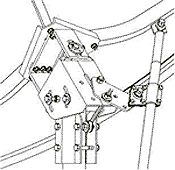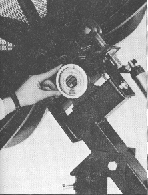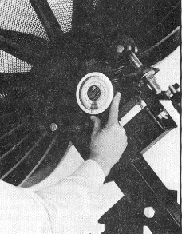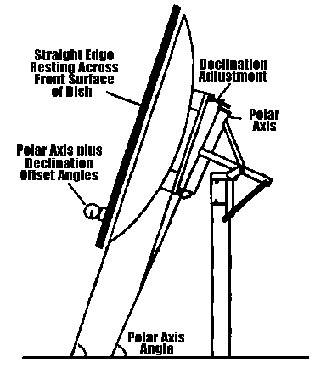|
Getting
Started - The Site Survey
Surveying the site is the first
step in a good installation. The purpose of the site survey is to
assure that several conditions are met that will ensure the proper
operation of the C-Band TV system. The conditions you are examining
are:
Is there an unobstructed view to
all of the satellite positions?
Will seasonal foliage cause
problems?
Is the area that the dish is to be
anchored into solid?
Are there sources of terrestrial
interference that need to be considered?
Make sure that there is nothing
that will obstruct the dish as it moves the full span of the sky.
You must verify that there are no transmissions in the 3.7 to 4.2
GHz frequency band that will cause problems with reception. An easy
way to verify this is to use a good LNB connected to a signal
strength meter. Move the LNB around the target area in a full
circle. If you notice any spikes of signal it is safe to assume
those same spikes may cause interference after the installation is
finished.
Planting
The Dish
A properly installed dish requires
a perfectly plumb pole and a well-anchored solid base. It is a good
idea to fill the pole with concrete as well as pouring a concrete
base; this will strengthen the installation and allow for more
accurate reception of both C and Ku-Band signals.
A good "rule of thumb"
is to use one bag of concrete for each full foot of dish size. A
seven and one half-foot dish needs a minimum of seven bags of
concrete as an anchor. If you are in a region where strong storms
are common, then more concrete is recommended.
 |
- Check for plumb in three
directions.
- Allow the concrete to harden for
at least 24 hours before dish mounting.
- Use braces that are welded or
drilled through the pole to prevent turning in the
concrete under load conditions.
|
Dish
Assembly
Every dish sold comes with
directions for assembly. Make sure you read the instructions before
attempting to assemble the dish! Some important things to remember:
- The dish needs to be perfectly
shaped. Use a measuring tape and measure across the diameter of
the dish in three directions. All measurements should be
identical.
- Tie a piece of string across
the diameter of the dish in two directions. The strings should
just barely touch at the center of the dish. If the strings are
pushed hard against each other or fail to touch, then the dish
is not properly assembled.
- Don't over tighten the
dish-mounting hardware. You do not want the ribs to be deformed
by pressure, as this will prevent proper alignment. Allow the
lock washers to perform the job of securing the bolts.
Mounting
the Feedhorn
The dish is a reflector that
focuses the energy into a small golf-ball sized orb at the mouth of
the feedhorn. Inside the feedhorn is a small antenna that is turned
by the servo motor to select vertical or horizontal polarity.
Knowing this will allow you to see how important it is to properly
mount the feedhorn.
Do not assume that because all the
supports holding the scalar ring are the same length that centering
is automatic. Make sure that all the supports are the same distance
from the edge of the dish to the scalar ring. Each measurement
should be within 1/32 of each other. You need to assure that the
scalar ring (the supporting ring for the feedhorn) is parallel to
the bottom of the dish and that it is perfectly centered in the
dish. If all this isn’t done, then you will have imperfect
reception. Having the focal point off by as little as one-half of
one inch can cause a fifty percent loss in signal strength!
A
Word About Focal Depth
The f/D ratio is the focal
distance of the dish (f), divided by the diameter (D). When dealing
with most prime focus antennas, the number should come out between
.28 and .42. If you notice, most of those numbers are also on scale
on the side of the feedhorn. You simply set the top edge of the
scalar ring even with the line that corresponds to your correct f/D
setting. What this adjustment actually does is determines how wide
of an angle the feedhorn can "see".
To calculate the focal distance,
you need to measure the diameter (D) and the depth (d) of the dish.
Measurements should be in like units (you can't use feet for the
diameter and inches for depth). For this example, let's say we have
a dish that is 120 inches in diameter (D) and 18 inches deep (d).
Focal distance (f) equals the diameter squared (D x D) divided by 16
times the depth (16 x d) or:
D x D = 120 x 120 = 14400
16 x d = 16 x 18 = 288
D x D/16 x d = 14400/288 = 50
Therefore focal distance f = 50
inches
After you have calculated the
focal distance (f), you can use that figure to calculate the f/D
ratio of your dish. In this case, using the same diameter of (D) =
120; and the calculated focal distance (f) = 50
f / D = 50 / 120 = .416
f /D = .416
And round up to give a setting of
.42.
All of this information will be
provided in the dish manufacturer’s instructions. It is important
to read the directions and understand the type of equipment you are
working with. Often times you will be working on a system that was
previously installed.
Feedhorn
Issues
Moisture is the enemy of microwave
reception. Making sure the feedhorn and LNB's are protected and
properly installed is very important to long-term, service-free
performance of a C-Band TV system.
Make sure that all coaxial cable
connections are crimped with a proper tool and treated to prevent
moisture from entering the cable. Make sure you use the gaskets
supplied with the LNB's to prevent moisture from entering the throat
of the feedhorn. Also, check to be sure the plastic covering for the
throat of the feedhorn is attached firmly to prevent both moisture
and pests from entering the waveguide.
The diagram below will point out
some sensitive areas you need to check to assure best performance.

Low
Noise Block Amplifiers - The LNB
The LNB is the electronic device
that mounts on the feedhorn and converts that golf-ball-sized globe
of RF energy into an electrical signal the IRD (receiver) can
understand and use. There are several kinds of LNB. There are
LNBF’s that use voltage on the coaxial cable to switch from
vertical to horizontal polarity. There are consumer grade LNB's that
use an external servo motor to turn the probe and select polarity.
And finally there are Digital or PLL (Phase Locked Loop) LNB's that
are normally used on commercial installations. It is highly
recommended that a PLL LNB be used on any high-quality TVRO
installation, whether consumer or commercial.
The biggest difference between a
normal LNB and a PLL LNB is the amount of frequency drift. No matter
the type of LNB, don't get caught up in a numbers war. Many
beginning installers think that a lower temperature LNB will always
be better than a higher temperature LNB. This is not necessarily
true. A PLL 25 degree LNB will almost always outperform a 17 degree
consumer (standard grade) LNB.
Also, you cannot make up for poor
dish alignment or installation with a better LNB or line amplifier.
The dish needs to collect the signal and send it cleanly to the
throat of the feedhorn. All the electronics in the world cannot help
the picture if you are losing half your signal and sending loads of
noise into the feedhorn. Use a good LNB, preferably a PLL LNB - but
spend your time making sure the mechanics of the dish are up to
snuff first.
The
Actuator Arm (The Dish Mover)
Now that we have the proper LNB
mounted on the feedhorn, the feedhorn mounted on the dish and
centered exactly, and the dish mounted on a plumb and properly
secured pole, we are ready to connect the actuator arm. Make sure
you use an actuator that is properly rated for the dish it is
attached to. You should never use an 18" actuator arm to try
and move a solid 12-foot dish! It may work for a while but the
chances are good that you will be replacing it in short order. Try
to get the best heavy-duty actuator arm you can - it will pay for
itself many times over in years of trouble free service.
There are two types of actuators:
the horizon-to-horizon mount that allows 180 degrees of
uninterrupted travel; and the linear actuator. The linear arm is far
and away the most common and will work just fine in almost
all-domestic installations. If you have a desire to view some of the
programming on the AOR (Atlantic Ocean Region) international
satellites or the corresponding Pacific Region birds, then by all
means try to get a horizon-to-horizon mount.
 |
Rear view of a
typical Linear Actuator Arm. This arm is set up for Linear
West Use.
|
A common error made by both new
installers and old-timers alike is in attaching the linear actuator
arm. East of the Mississippi a Linear West setting is used. This
seems counter-intuitive at first but closer examination will reveal
the sense of this set-up. We want the actuator arm to push the dish
into position and let gravity help to return it. From the eastern
part of the country the lowest satellites will be on the western
side of the arc. Therefore position the actuator arm on the west
side of the dish (on the right when looking at the dish from
behind). From the western part of the country the situation is
reversed and the lowest satellites will be the eastern birds. West
of the Mississippi, the actuator arm is attached to the left of the
dish and called a Linear East Mount.
Correct choice of linear east or
west will increase the useful life of the actuator arm. More
importantly, on very sophisticated IRD's the receiver actually uses
the pulses from the reed sensor switch to predict where a satellite
should be. Misidentifying the type of actuator (calling it linear
east when it is, in fact, linear west) is the most common problem in
using an auto-installation feature.
Aligning
The Dish
Now we come to the hardest part of
the installation. If you pay close attention to the following
procedures it will pay off in the long run with better reception on
Ku-Band and weaker C-Band satellites.
Three adjustments are required to
ensure proper tracking of the arc: Azimuth (north/south heading),
declination offset angle and polar axis angle (inclination angle).
These parameters should be set while the dish is aimed toward its
highest position, namely towards the southern-most satellite.
The azimuth must be set right in
order to detect all the satellites in the viewable arc. Most dishes
have a flat plate on the mount that can be used as a sighting
reference. A hand-held compass is the most effective type for lining
up the mount. Remember that a correction for magnetic variation is
necessary. Add magnetic variation to the compass heading for west
magnetic variation; subtract for east.
The polar axis angle or
inclination angle is within fractions of the site latitude. Most
mounts have one or two long threaded rods that are used to adjust
the polar axis angle. An inclinometer resting on the axis bar or
back part of the mount is used to set this angle.

|
Setting the Polar
Axis Angle - The polar axis angle is set by placing an
inclinometer on the polar bar and then raising or lowering
the dish to that angle. |
The declination offset adjustment
lowers the sight of a dish to the arc of the satellites. Declination
is greater in locations farther away from the equator. Just like the
offset angle, it is measured with an inclinometer. The difference
between the two readings, one on the main bar, and one on a flat
spot on the back of the dish, should be equal to the declination
offset. The easiest way to set the declination offset is with an
inclinometer placed on the back surface that is parallel with the
face of the dish. Or via a flat board placed in a vertical direction
spanning the rims. This reading should be equal to the sum of the
polar axis and declination angles.
-

|
Setting the Declination Angle -
The declination angle is set by placing an inclinometer on a
flat service of the dish that is parallel to the line
between the rims and adjusting the declination bolts until
the reading equals the sum of the polar axis and destination
angles. |
| Using the Dish Face to Set A
Declination Angle - If a flat surface cannot be found on
the rear of the dish or on the hardware that supports the
declination adjustment, the declination angle can be set by
placing an inclinometer on a flat board that rests on the
face of the dish. |

|
Determine the latitude of your
installation by using a map. Below is a table where you can look up
the polar axis, and declination angle as well the apex elevation for
your latitude.
|
Latitude
|
Polar Axis
|
Declination Angle
|
Apex Elevation
|
Latitude
|
Polar Axis
|
Declination Angle
|
Apex Elevation
|
Latitude
|
Polar Axis
|
Declination Angle
|
Apex Elevation
|
|
0.00
|
0.00
|
0.00
|
90.00
|
|
27.00
|
27.59
|
3.94
|
58.47
|
|
54.00
|
54.67
|
6.97
|
28.36
|
|
0.50
|
0.51
|
0.08
|
89.41
|
|
27.50
|
28.10
|
4.01
|
57.89
|
|
54.50
|
55.16
|
7.02
|
27.82
|
|
1.00
|
1.02
|
0.16
|
88.82
|
|
28.00
|
28.61
|
4.07
|
57.32
|
|
55.00
|
55.66
|
7.06
|
27.28
|
|
1.50
|
1.54
|
0.22
|
88.24
|
|
28.50
|
29.11
|
4.14
|
56.74
|
|
55.50
|
56.16
|
7.10
|
26.74
|
|
2.00
|
2.06
|
0.30
|
87.64
|
|
29.00
|
29.62
|
4.20
|
56.18
|
|
56.00
|
56.65
|
7.14
|
26.21
|
|
2.50
|
2.57
|
0.38
|
87.05
|
|
29.50
|
30.13
|
4.27
|
55.60
|
|
56.50
|
57.14
|
7.19
|
25.67
|
|
3.00
|
3.08
|
0.46
|
86.47
|
|
30.00
|
30.63
|
4.33
|
55.03
|
|
57.00
|
57.64
|
7.22
|
25.14
|
|
3.50
|
3.60
|
0.52
|
85.88
|
|
30.50
|
31.14
|
4.41
|
54.46
|
|
57.50
|
58.14
|
7.26
|
24.60
|
|
4.00
|
4.11
|
0.60
|
85.29
|
|
31.00
|
31.64
|
4.47
|
53.89
|
|
58.00
|
58.63
|
7.30
|
24.06
|
|
4.50
|
4.62
|
0.68
|
84.70
|
|
31.50
|
32.16
|
4.52
|
53.32
|
|
58.50
|
59.12
|
7.35
|
23.53
|
|
5.00
|
5.13
|
0.76
|
84.11
|
|
32.00
|
32.66
|
4.59
|
52.75
|
|
59.00
|
59.61
|
7.39
|
23.00
|
|
5.50
|
5.65
|
0.83
|
83.52
|
|
32.50
|
33.17
|
4.65
|
52.18
|
|
59.50
|
60.11
|
7.42
|
22.47
|
|
6.00
|
6.16
|
0.91
|
82.93
|
|
33.00
|
33.67
|
4.71
|
51.62
|
|
60.00
|
60.59
|
7.47
|
21.94
|
|
6.50
|
6.67
|
0.99
|
82.35
|
|
33.50
|
34.17
|
4.78
|
51.05
|
|
60.50
|
61.08
|
7.51
|
21.41
|
|
7.00
|
7.18
|
1.06
|
81.76
|
|
34.00
|
34.68
|
4.85
|
50.47
|
|
61.00
|
61.58
|
7.54
|
20.88
|
|
7.50
|
7.70
|
1.13
|
81.17
|
|
34.50
|
35.18
|
4.91
|
49.91
|
|
61.50
|
62.07
|
7.58
|
20.35
|
|
8.00
|
8.21
|
1.21
|
80.58
|
|
35.00
|
35.68
|
4.97
|
49.35
|
|
62.00
|
62.57
|
7.61
|
19.82
|
|
8.50
|
8.72
|
1.29
|
79.99
|
|
35.50
|
36.18
|
5.03
|
48.78
|
|
62.50
|
63.06
|
7.64
|
19.30
|
|
9.00
|
9.23
|
1.36
|
79.41
|
|
36.00
|
36.69
|
5.09
|
48.22
|
|
63.00
|
63.55
|
7.68
|
18.77
|
|
9.50
|
9.74
|
1.44
|
78.82
|
|
36.50
|
37.19
|
5.15
|
47.66
|
|
63.50
|
64.05
|
7.71
|
18.24
|
|
10.00
|
10.26
|
1.51
|
78.23
|
|
37.00
|
37.69
|
5.21
|
47.10
|
|
64.00
|
64.53
|
7.75
|
17.72
|
|
10.50
|
10.77
|
1.59
|
77.65
|
|
37.50
|
38.20
|
5.27
|
46.53
|
|
64.50
|
65.02
|
7.78
|
17.19
|
|
11.00
|
11.29
|
1.65
|
77.06
|
|
38.00
|
38.70
|
5.33
|
45.97
|
|
65.00
|
65.52
|
7.80
|
16.68
|
|
11.50
|
11.80
|
1.73
|
76.47
|
|
38.50
|
39.20
|
5.39
|
45.41
|
|
65.50
|
66.01
|
7.84
|
16.15
|
|
12.00
|
12.31
|
1.80
|
75.89
|
|
39.00
|
39.70
|
5.45
|
44.85
|
|
66.00
|
66.50
|
7.87
|
15.63
|
|
12.50
|
12.82
|
1.88
|
75.30
|
|
39.50
|
40.21
|
5.51
|
44.29
|
|
66.50
|
66.99
|
7.90
|
15.11
|
|
13.00
|
13.32
|
1.96
|
74.72
|
|
40.00
|
40.71
|
5.56
|
43.73
|
|
67.00
|
67.48
|
7.93
|
14.59
|
|
13.50
|
13.84
|
2.03
|
74.13
|
|
40.50
|
41.21
|
5.62
|
43.17
|
|
67.50
|
67.97
|
7.96
|
14.07
|
|
14.00
|
14.35
|
2.10
|
73.55
|
|
41.00
|
41.71
|
5.67
|
42.61
|
|
68.00
|
68.47
|
7.98
|
13.55
|
|
14.50
|
14.86
|
2.18
|
72.96
|
|
41.50
|
42.22
|
5.73
|
42.05
|
|
68.50
|
68.96
|
8.01
|
13.03
|
|
15.00
|
15.37
|
2.25
|
72.38
|
|
42.00
|
42.72
|
5.78
|
41.50
|
|
69.00
|
69.45
|
8.04
|
12.51
|
|
15.50
|
15.89
|
2.32
|
71.79
|
|
42.50
|
43.22
|
5.84
|
40.94
|
|
69.50
|
69.95
|
8.06
|
11.99
|
|
16.00
|
16.40
|
2.39
|
71.21
|
|
43.00
|
43.72
|
5.89
|
40.39
|
|
70.00
|
70.43
|
8.09
|
11.48
|
|
16.50
|
16.91
|
2.47
|
70.62
|
|
43.50
|
44.22
|
6.00
|
39.83
|
|
70.50
|
70.92
|
8.12
|
10.96
|
|
17.00
|
17.42
|
2.54
|
70.04
|
|
44.00
|
44.72
|
6.00
|
39.28
|
|
71.00
|
71.41
|
8.15
|
10.45
|
|
17.50
|
17.93
|
2.61
|
69.46
|
|
44.50
|
45.21
|
6.05
|
38.73
|
|
71.50
|
71.90
|
8.17
|
9.93
|
|
18.00
|
18.44
|
2.68
|
68.88
|
|
45.00
|
45.71
|
6.11
|
38.17
|
|
72.00
|
72.39
|
8.19
|
9.42
|
|
18.50
|
18.95
|
2.76
|
68.29
|
|
45.50
|
46.21
|
6.17
|
37.62
|
|
72.50
|
72.88
|
8.21
|
8.91
|
|
19.00
|
19.46
|
2.82
|
67.72
|
|
46.00
|
46.71
|
6.21
|
37.08
|
|
73.00
|
73.37
|
8.23
|
8.40
|
|
19.50
|
19.97
|
2.90
|
67.13
|
|
46.50
|
47.21
|
6.27
|
36.52
|
|
73.50
|
73.86
|
8.25
|
7.89
|
|
20.00
|
20.47
|
2.97
|
66.56
|
|
47.00
|
47.70
|
6.32
|
35.98
|
|
74.00
|
74.35
|
8.27
|
7.38
|
|
20.50
|
20.98
|
3.05
|
65.97
|
|
47.50
|
48.20
|
6.38
|
35.42
|
|
74.50
|
74.84
|
8.29
|
6.87
|
|
21.00
|
21.50
|
3.11
|
65.39
|
|
48.00
|
48.70
|
6.42
|
34.87
|
|
75.00
|
75.33
|
8.31
|
6.36
|
|
21.50
|
22.01
|
3.18
|
64.81
|
|
48.50
|
49.20
|
6.47
|
37.33
|
|
75.50
|
75.82
|
8.33
|
5.85
|
|
22.00
|
22.52
|
3.25
|
64.23
|
|
49.00
|
49.70
|
6.51
|
33.79
|
|
76.00
|
76.37
|
8.35
|
5.34
|
|
22.50
|
23.03
|
3.32
|
63.65
|
|
49.50
|
50.19
|
6.57
|
33.24
|
|
76.50
|
76.80
|
8.37
|
4.83
|
|
23.00
|
23.54
|
3.38
|
63.08
|
|
50.00
|
50.69
|
6.62
|
32.69
|
|
77.00
|
77.29
|
8.38
|
4.33
|
|
23.50
|
24.04
|
3.46
|
62.50
|
|
50.50
|
51.19
|
6.67
|
32.14
|
|
77.50
|
77.78
|
8.40
|
3.82
|
|
24.00
|
24.55
|
3.53
|
61.92
|
|
51.00
|
51.69
|
6.70
|
31.61
|
|
78.00
|
78.27
|
8.41
|
3.32
|
|
24.50
|
25.06
|
3.60
|
61.34
|
|
51.50
|
52.18
|
6.76
|
31.06
|
|
78.50
|
78.75
|
8.43
|
2.82
|
|
25.00
|
25.57
|
3.66
|
60.77
|
|
52.00
|
52.68
|
6.80
|
30.52
|
|
79.00
|
79.24
|
8.45
|
2.31
|
|
25.50
|
26.07
|
3.74
|
60.19
|
|
52.50
|
53.18
|
6.85
|
29.97
|
|
79.50
|
79.73
|
8.46
|
1.81
|
|
26.00
|
26.58
|
3.80
|
59.62
|
|
53.00
|
53.67
|
6.89
|
29.43
|
|
80.00
|
80.22
|
8.47
|
1.31
|
|
26.50
|
27.09
|
3.87
|
59.04
|
|
53.50
|
54.17
|
6.94
|
28.89
|
|
80.50
|
80.71
|
8.48
|
0.80
|
|
|
|
|
|
|
|
|
|
|
81.00
|
81.19
|
8.50
|
0.30
|
When the declination is
properly set, the procedure is to set the dish to true south (not
magnetic south). You need to compensate and use the polar axis
adjustment to capture the southernmost satellite visible from your
location. This is called the zenith satellite. Once you are peaked
at the southernmost satellite you can use the actuator control on
your receiver to move the dish to the lowest satellite off the
horizon you can see. This is called the extreme satellite.
Once you have located the extreme
satellite, gently push up and down on the edge of the dish to see
which direction helps clear up the picture. If pushing down on the
lip of the dish clears up the picture, then you need to rotate the
polar mount counterclockwise. If pushing up on the lip of the dish
clears up the picture, then you need to rotate the polar mount
clockwise on the pole.
After you have made the azimuth
adjustment, return the dish to the southernmost satellite and use
the elevation adjustment to clear the picture up. Keep moving back
and forth between the extreme satellite and the zenith satellite
using the polar adjustment and the elevation adjustment respectively
until the dish tracks the arc.
|